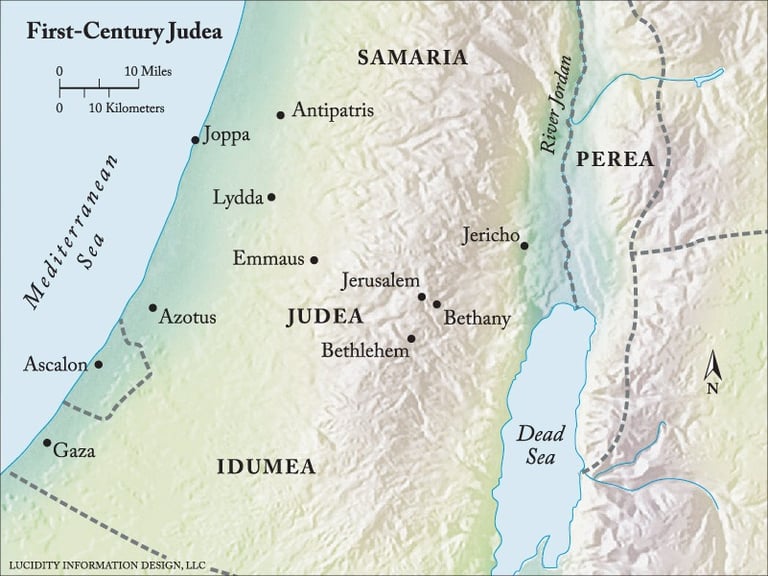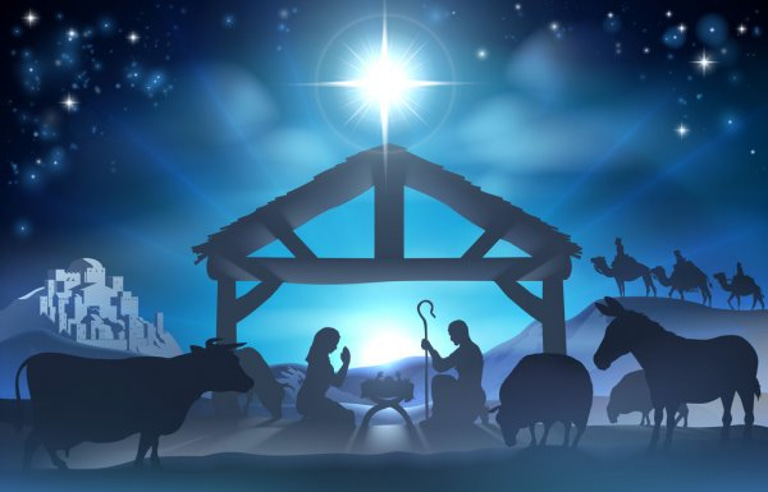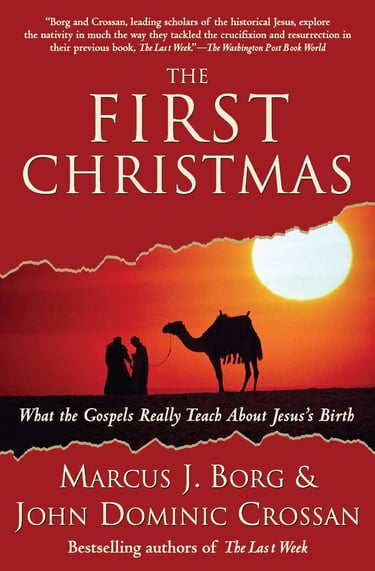Unveiling the Ethnic Mosaic: The Multicultural Roots of the Nativity
Explore the historical context of Jesus' birth. Understand how first-century social dynamics enrich the Nativity's significance.
Grace Callahan
11/22/20248 min read


The Geopolitical Tapestry of First-Century Judea: A Complex Ethnic Landscape
The world into which Jesus was born was shaped by centuries of cultural interaction, imperial conquest, and migration. Judea was far from being an isolated Jewish territory; it was a vibrant mosaic of different ethnicities, cultures, and political influences.
Imperial Dynamics and Cultural Confluence
Roman Influence: By the time of Jesus' birth, Judea was under Roman rule, although it was governed as a client state through the Herodian Dynasty. The Romans introduced their legal system, military presence, and imperial architecture, dramatically altering the political landscape of Judea. Roman law and governance affected the lives of Jewish residents, including taxation policies like the census that led Mary and Joseph to travel to Bethlehem (Luke 2:1-5).
Cultural Syncretism: Roman occupation didn’t simply bring governance—it also brought the spread of Roman culture, including art, religion, and societal structures. This integration of cultures led to the development of hybrid forms of religious and philosophical practices, merging local Jewish beliefs with Roman customs.
Hellenistic Influence: Following the conquests of Alexander the Great, Greek culture had permeated much of the Mediterranean world. Greek language, philosophy, and art left an indelible mark on Judea, especially in urban areas. The Greek language was widely spoken, particularly in cosmopolitan areas such as Jerusalem, where many Jews were bilingual in both Greek and Aramaic.
Other Influences: Judea’s proximity to other great powers—such as Egypt, Syria, and the Arabian Peninsula—meant that it was not an isolated society. The presence of Nabataean traders, Egyptian migrants, and Syrian settlers added further complexity to the region’s ethnic makeup. These groups brought their own customs, religions, and languages, contributing to the multicultural fabric of the region.
Demographic Complexity
Judea was home to a vast and diverse population, with multiple ethnic and linguistic groups coexisting. Here’s a breakdown of some of the key groups that lived in the region during the time of the Nativity:
Jewish Populations (70-80%): The majority of Judea’s population was ethnically Jewish, speaking primarily Aramaic, a Semitic language that had become the common vernacular after the Babylonian exile. Hebrew remained the liturgical language, used in synagogues and religious contexts. Jewish society was also heavily influenced by religious traditions, and the expectations of the Messiah were a prominent theme in the local culture.
Greek-speaking Populations: Greek was the lingua franca of the Eastern Roman Empire, and in urban centers like Jerusalem and Caesarea Maritima, Greek-speaking populations (both Jews and non-Jews) were prevalent. These urbanites contributed to the cosmopolitan nature of Judean society, engaging in trade, intellectual exchange, and administrative roles.
Roman Military and Administrative Personnel: Romans stationed in Judea represented imperial authority. This included soldiers, administrators, and governors, who introduced Roman customs and laws. Their presence served as a reminder of the ongoing Roman occupation, as reflected in the census that brought Mary and Joseph to Bethlehem.
Nabataean Traders and Settlers: The Nabataeans, an Arabian people known for their trade routes and cities like Petra, had a strong presence in the region, particularly along trade routes connecting the East and the West. Their presence in Judea facilitated cross-cultural exchanges in goods, ideas, and even religious practices.
Syrian and Egyptian Migrants: Due to political and economic factors, Judea also saw the migration of people from Syria and Egypt. These groups brought their distinct religious beliefs and traditions, further adding to the cultural diversity of the region.
Ethnic Identities of Nativity Protagonists: Beyond Conventional Narratives
The central figures of the Nativity—Mary, Joseph, and the Magi—were products of this multicultural world. Each of them represents a blend of religious, ethnic, and cultural identities shaped by the complex social environment of first-century Judea.
Mary: A Woman of Profound Cultural Complexity
Mary, the mother of Jesus, is one of the most iconic figures in the Christian faith. However, her role must be viewed within the context of the rich cultural and ethnic tapestry of her time.
Primary Language and Cultural Practices: As a young Jewish woman in first-century Judea, Mary would have primarily spoken Aramaic, a Semitic language closely related to Hebrew. This was the common language of the Jewish people in Judea, although she may also have had some knowledge of Hebrew for religious texts and of Greek, which was useful for communication in urban areas.
Genealogy and Social Status: Mary’s Jewish heritage would have placed her within a deeply rooted cultural and religious context. She likely came from a family that was deeply involved in Jewish religious life, following practices such as circumcision, the Sabbath, and Passover. Her genealogical background would have been significant, possibly linking her to the tribe of Judah, which was important for the messianic prophecies.
Genetic and Anthropological Insights
Semitic Ancestry: Archaeological and genetic evidence suggests that Mary’s physical appearance would have been reflective of the Semitic populations native to Judea. Her features likely included dark skin, dark hair, and brown eyes, consistent with the Jewish populations of the region.
Mediterranean Influence: Due to Judea’s location at the crossroads of Africa, Asia, and Europe, Mary’s genetic heritage may have included Mediterranean influences from surrounding populations such as Egyptians, Greeks, and Syrians, who were frequent migrants or traders in the region.
Joseph: Tribal Identity and Social Navigation
Joseph, the earthly father of Jesus, represents the complex intersection of tribal heritage, religious duty, and practical survival in a Roman-occupied territory.
Davidic Lineage: Joseph’s descent from King David placed him within the Jewish messianic tradition. His connection to the Davidic line was important, as it fulfilled the prophecies regarding the Messiah’s lineage. However, Joseph’s role in the Nativity story is more than genealogical—it also highlights his practical role in navigating Roman and Jewish social systems.
Craftsmanship and Trade: As a tekton (often translated as “carpenter” but more accurately “builder”), Joseph would have possessed skills that allowed him to engage with the broader, diverse population of Judea. He likely worked with both Jews and non-Jews, especially in urban areas where construction projects would have been a significant part of the economy.
Religious Devotion: Joseph’s actions, including his willingness to take Mary as his wife despite the social stigma surrounding her pregnancy, reflect a deep commitment to Jewish law and tradition. His role in protecting Mary and Jesus also underscores his role as a caretaker and protector, fulfilling his religious and familial duties.
The Wise Men: An Intellectual and Cultural Delegation
The Magi, often described as the "three wise men," were figures of great importance in the ancient world. They were not merely travelers but intellectual and spiritual leaders who represented the intersections of multiple cultures and religious traditions.
Origins from Parthian Persia: The Magi likely came from Parthia (modern-day Iran), an empire that was in direct competition with Rome for regional dominance. As members of the priestly class in the Zoroastrian religion, the Magi were scholars with advanced knowledge of astrology, astronomy, and philosophy.
Zoroastrian and Astronomical Knowledge: The Magi were not only religious leaders but also skilled astronomers. Their knowledge of the stars and the prophetic significance of celestial events, such as the Star of Bethlehem, speaks to the advanced scientific knowledge they possessed. This knowledge was deeply intertwined with their religious practices, as Zoroastrianism held a cosmic view of the universe.
Diplomatic and Intellectual Networks: The Magi likely traveled as part of a broader diplomatic or intellectual mission, symbolizing the interconnectedness of the ancient world. Their presence in Judea, where they honored the newborn Jesus, demonstrates the potential for cross-cultural understanding and the blending of intellectual traditions from different parts of the world.
Cultural Interactions: Beyond Simple Binaries
The Nativity story transcends simplistic ideas of cultural separation and instead presents a narrative rich with cultural negotiation, adaptation, and mutual respect.
Migration and Mobility
The journey of Mary and Joseph to Bethlehem, driven by the Roman census, illustrates the reality of movement and migration in the ancient world:
Roman Administrative Influence: The census mandated by Caesar Augustus was a tool of Roman governance, requiring individuals to return to their ancestral homes. This policy forced people to travel long distances, impacting their lives in ways that reflect the deep control the Roman Empire had over its territories.
Cultural Mobility: The journey itself symbolizes the mobility of peoples across Judea, which was not an isolated region but one that interacted with a vast network of cultures and empires. It highlights the interconnectedness of the ancient world, where individuals from different ethnic and cultural backgrounds could meet and interact.
Religious and Cultural Negotiations
The interactions between Mary, Joseph, the Magi, and others in the Nativity story showcase how different cultural and religious traditions could interact, and sometimes even overlap, in meaningful ways:
Jewish, Roman, and Persian Traditions: The Nativity story includes a meeting between Jewish, Roman, and Persian traditions—each of which brings a unique perspective to the birth of Jesus. The Jewish context shapes much of the narrative, while the Roman presence influences the political setting, and the Magi bring an Eastern, Zoroastrian understanding of the divine and the cosmos.
Diplomatic Exchanges: The Magi’s visit reflects the broad intellectual and diplomatic exchanges that occurred across empires. Their journey to honor a Jewish child demonstrates the cultural respect that existed, even between competing empires.
Unexpected Cultural Connections
One of the most powerful elements of the Nativity story is its ability to bring together people from different cultures and backgrounds. The Magi’s journey from the East to acknowledge the Jewish Messiah reflects a moment of cross-cultural understanding that transcends national, ethnic, and religious boundaries.
Theological Implications of Ethnic Diversity
The ethnic diversity represented in the Nativity story carries profound theological meaning. It suggests a divine narrative that is not confined to a specific group but encompasses the diversity of human experience.
A Message for All Peoples: The presence of the Magi and the recognition of Jesus by people from distant lands suggest that the message of Jesus transcends tribal and national boundaries. It is a message for all people, regardless of their ethnic or cultural background.
Celebrating Diversity: The Nativity story highlights the richness of human diversity and invites believers to celebrate this diversity as part of the divine plan. It reinforces the idea that all cultures have a place in the story of salvation.
Inclusivity as a Spiritual Principle: The theological message of the Nativity emphasizes inclusivity, a theme that resonates deeply in a world marked by division and conflict. Jesus' birth is presented as a unifying moment for all of humanity.
Contemporary Relevance
In a world that is increasingly defined by migration, global interconnectedness, and cultural negotiation, the Nativity story offers valuable lessons:
Fluid and Multifaceted Identities: The identities of Mary, Joseph, and the Magi reflect the fluidity of identity in a globalized world. The modern experience of living between cultures or adapting to new environments mirrors the lives of those in the Nativity story.
Meaningful Cross-Cultural Connections: The Nativity story suggests that true understanding and connection can emerge when people from different backgrounds meet with respect and openness.
The Richness of Diversity: The story invites modern readers to recognize the richness of diversity and the potential for growth and transformation that comes from engaging with different cultures.
Conclusion: A Universal Narrative of Human Complexity
The Christmas Nativity story is a profound and multifaceted narrative that speaks to the complexity of the human condition. It invites us to see beyond cultural and ethnic boundaries and to recognize the divine potential inherent in human diversity. By understanding the ethnic and cultural foundations of this story, we can gain deeper insights into both its historical significance and its spiritual message.
Additional Readings and Authoritative References
“The Historical Jesus: The Life of a Mediterranean Jewish Peasant” by John Dominic Crossan – Offers a scholarly exploration of the cultural and historical context of the life of Jesus.
“The First Christmas: What the Gospels Really Teach About Jesus's Birth” by Marcus J. Borg and John Dominic Crossan – Examines the Nativity story from a historical and cultural perspective.
“Jesus Through Middle Eastern Eyes: Cultural Studies in the Gospels” by Kenneth E. Bailey – Provides insights into the social and cultural contexts of the Nativity story.
“The Magi: A Study in the History and Mythology of the Three Kings” by John W. Drane – Explores the historical and symbolic significance of the Magi.
These texts offer further exploration into the cultural and theological implications of the Nativity story and its multicultural roots.




